Movie Review By: SFAM
Year: 2002
Directed by: Kazuto Nakazawa & Naoyuki Yoshinaga
Written by: Chiaki Konaka
IMDB Reference
Degree of Cyberpunk Visuals: High
Correlation to Cyberpunk Themes: Medium
Key Cast Members:
Basil: Kazuhiko Inoue
Reiko Michaelson: Akemi Okamura
Rod Kimball: Somei Uchida
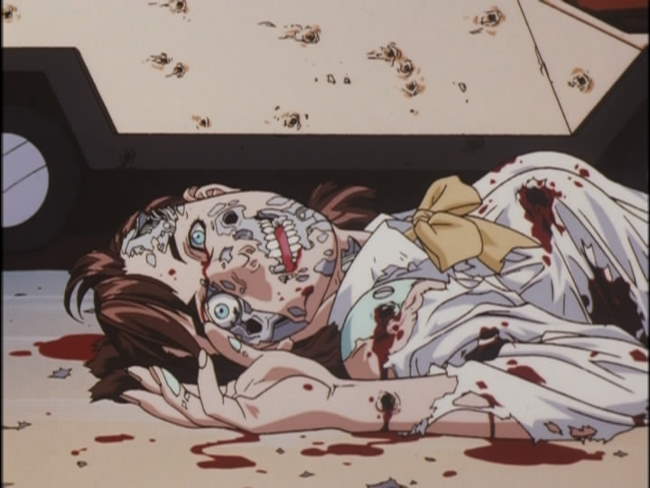
Overview: Parasite Dolls, another cyberpunk anime written by the prolific cyberpunk anime master, Chiaki Konaka (Serial Experiments Lain, Texhnolyze, Armitage III, Malice@Doll, and Bubblegum Crisis 2040), is a visually interesting, VERY adult OVA from the Bubblegum Crisis universe. The androids (called boomers) in this show are fully android (at least regarding their mental processes) unlike in other Bubblegum stories where they seem to be a combination of human and android. While this is a three part OVA, I really like that they are almost integrated like a movie, versus as separate episodes. Fair warning, you get gruesome deaths in the throws of sex, prostitution, lots and lots of gore.
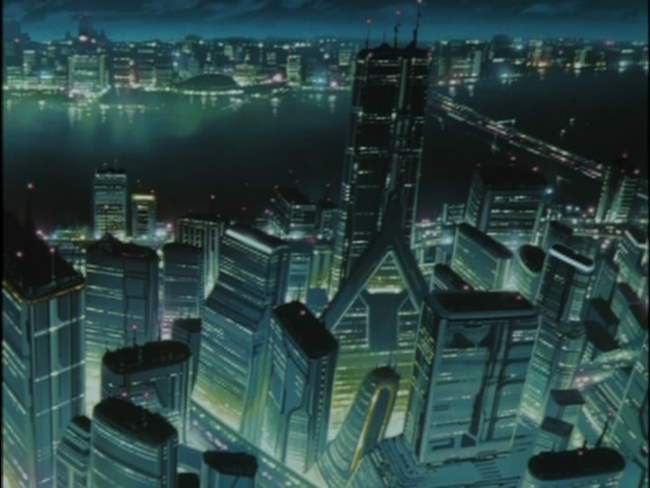
The Stories: There are three separate, interlinked stories on the Parasite Dolls OVA. At the start of the first story, set in the year 2034, where society has become a troubled mix of humans and androids called “Boomers.” The Genom Cooperation has created boomers to serve mankind in all aspects, from police support to sex dolls. Unfortunately, problems emerge, both with the boomers and with humanity’s reaction to their presence. A clandestine division of the Advanced Police (A.D Police) called “Branch” has been created to investigate human to boomer related crimes. The story follows “Buzz” Nikvest, a policeman with a troubled past, and his partners at the Branch division, which include a very helpful Boomer called Kimball and a stereotyped spunky, sexy, tough cop chick named Reiko Michaelson.
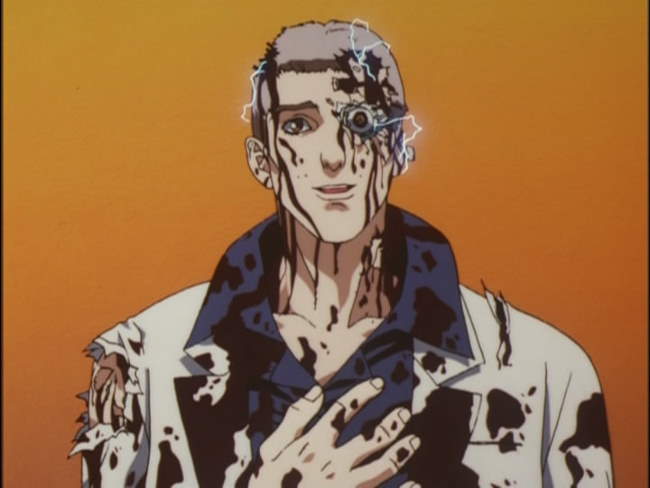
In the first episode, rogue boomers start randomly attacking and killing innocent humans. Buzz and company are brought in to investigate. During the course of their investigation, they find that things at the Genom corporation are not all above board. This story has some pretty cool visuals of shot-up boomers, and a few interesting
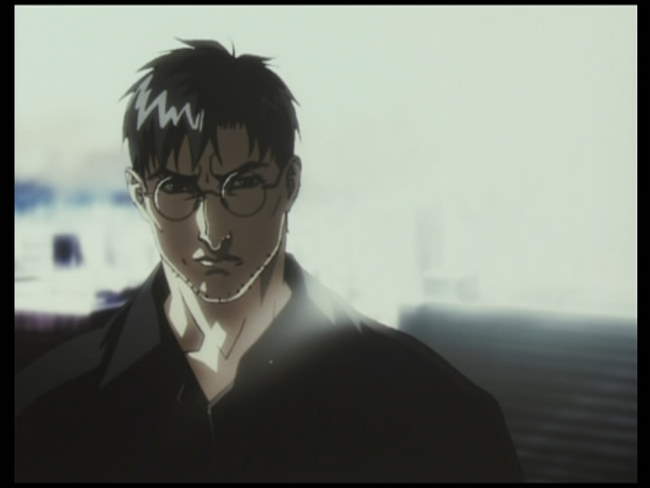
The second episode, which takes place a year later, involves a truly bizarre android monster called the “Boomer Crusher” and a very lifelike boomer prostitute who has feelings and has dreams. Unfortunately, the prostitute is being controlled in her dreams to cause some truly bizarre human deaths. We find out more in the third story of who probably created this monster, but it isn’t really stated in the narrative.
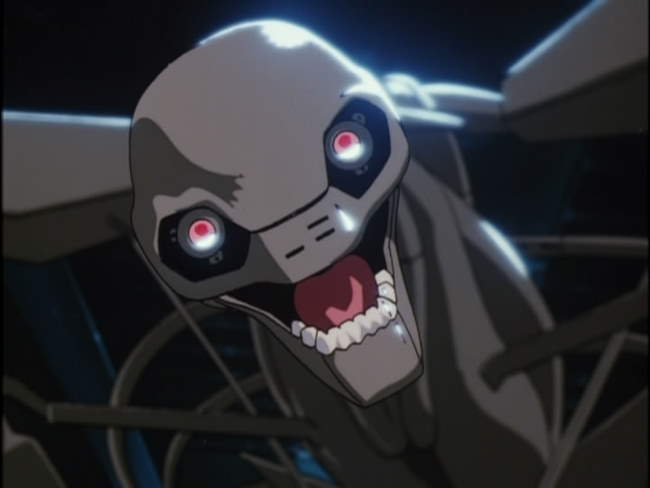
In the third episode, which takes place 5 years later, Takahashi, the head of Branch Division is missing. In searching for their missing box, Buzz, Kimball and Reiko find a connection between Takahashi’s disappearance and the recent spate of anti-boomer activity that has grown in recent years. Worse, as explosions go off all over the city, Buzz is framed as the fall guy. As the story unfolds, the viewer is left with the idea that all three stories are related to the same larger plot.
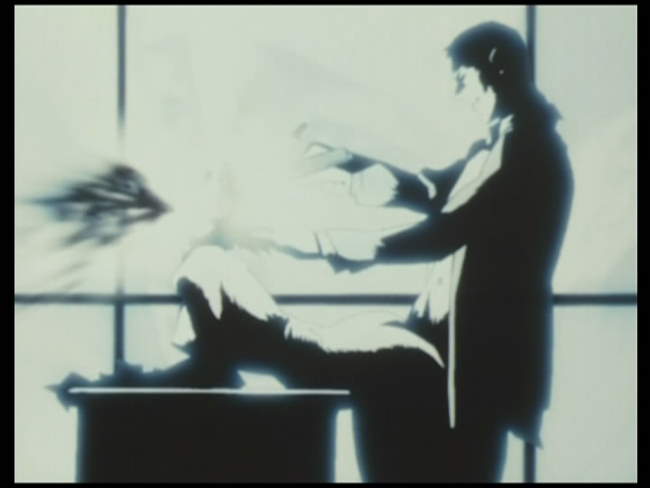
The Visuals: Parasite Dolls has a really nice diversity of looks, often emphasizing extreme shadows in single color light settings. Both blue and gray are used extensively for this, often yielding terrific visuals. In other cases, Parasite Dolls looks like a rather decent, but not spectacular anime. It does best when it strives for the edgy look. Had this been used throughout, Parasite Dolls could have come off as something bordering on special. As it stands, some parts really stand out, while others you almost wait to get through.
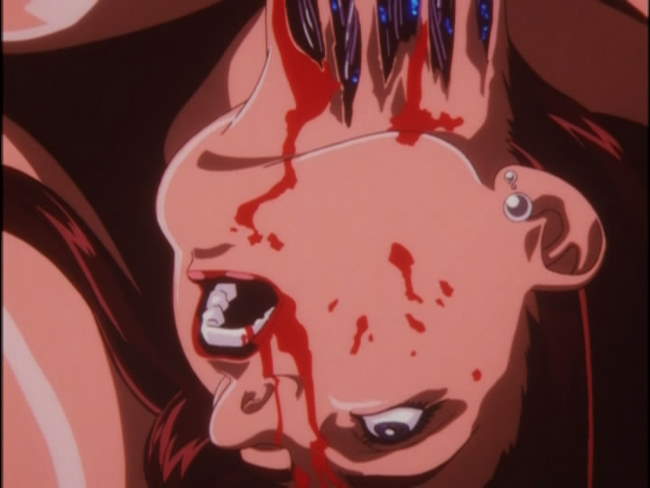
Boomers – property or unique individuals: Nothing new here – Parasite Dolls explores the continually explored question of whether androids are merely property or something more unique. Unfortunately, no new ground is traversed. Instead, the interesting aspects of this come from the seedy visuals themselves. There are a few scenes in Parasite Dolls where the visuals make a far more interesting statement than the narrative. These usually involve truly gruesome Boomer deaths.
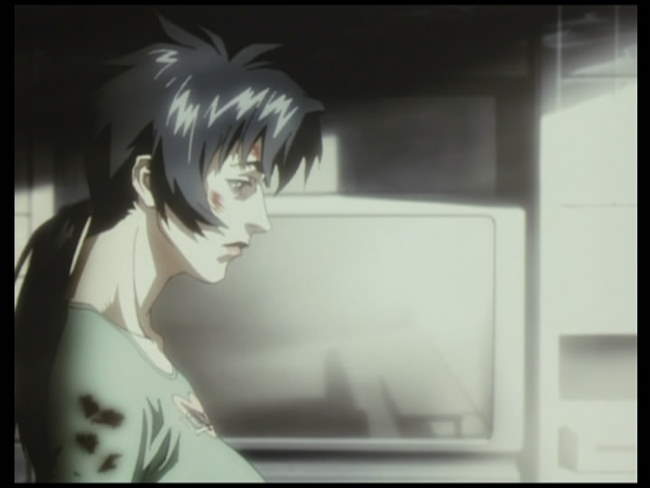
The Seedy Underground: A seedy feeling pervades Parasite Dolls. We get nudie bars, slovenly side-walks, seedy corporate meetings, and absolutely base human behavior. We have hot chick boomers continually debased and abused. Even the weird creatures that appear have an icky feel to them. The constant theme we see here are fallen boomers. They had so much potential, but…
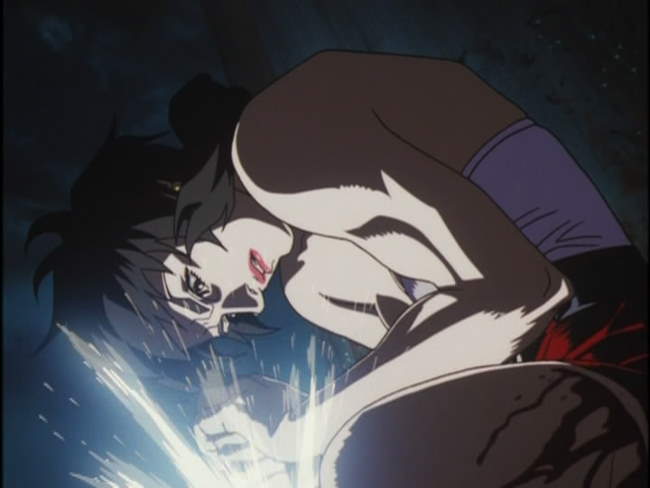
The Bottom Line: The stories themselves are somewhat uneven and problematic, but the visuals are interesting enough to make this worth a watch. While the narrative is more straight forward than many of Chiaki Konaka’s stories, it does require a few minutes thought to put the overall picture together – otherwise, all three episodes almost seem disconnection. Even though Buzz is a pretty interesting character, the rest of the characters we encounter are pretty much the cookie-cutter variety. Worse, as the episodes take place over a six-year time period, you would really expect to see growth in the characters, or at least changes in the nature of their relationships. Instead, the characters we encounter at the beginning are the same ones six years later. Still, for a 3 part OVA, Parasite Dolls is worth a watch for the visuals alone.
~See movies similar to this one~
Movie Review By: SFAM
Year: 1998
Directed by: Neill Fearnley
Written by: Wynne McLaughlin
IMDB Reference
Degree of Cyberpunk Visuals: Low
Correlation to Cyberpunk Themes: Medium
Key Cast Members:
Johnny Dalton: Jeff Fahey
Nikki Holland: Tahnee Welch
Frank Donahue: Michael Ironside
Bosch: John Neville
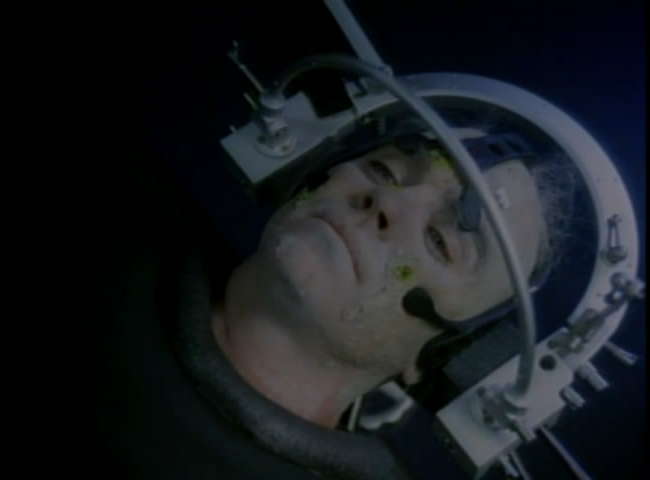
Overview: Some low-budget movies make it with a terrific story and just the right quality of effects; others come close; and others still get worried about not quite making it, so they decide to spew insane plot twists at the viewer in the hopes of increasing the tension. Unfortunately, Johnny 2.0 takes this tact. The movie was “teetering on the edge” of being decent, but fell off the wrong side. Instead of going with the stream of increasingly unbelievable plot twists, had they spent just a bit more on beefing up the story, Johnny 2.0 could have gotten some real kudos.
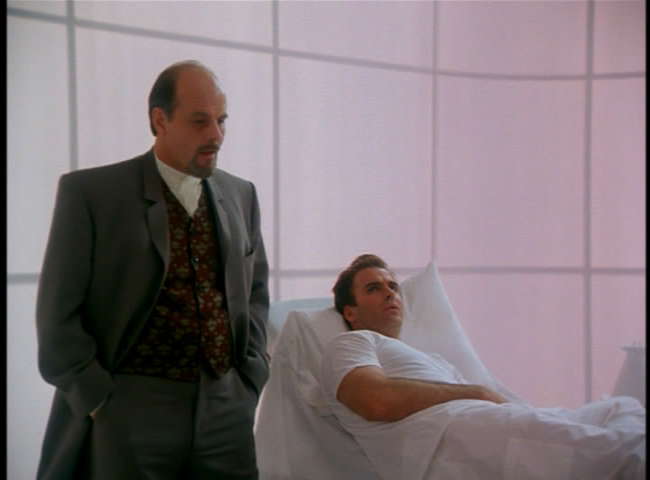
The Story: In the present, the experimentation with cloning begins to take off when scientist Johnny Dalton (Jeff Fahey) teams up with Frank Donahue (Michael Ironside) to create a small cloning start-up that has terrific potential. They are able to speed up the cloning process, and more surprisingly, are able to take an MRI scan of a person’s brain in a way that can record their entire set of memories. Unfortunately, anti-technology terrorists attack their complex and severely hurt Johnny, causing a massive, bleeding head injury.
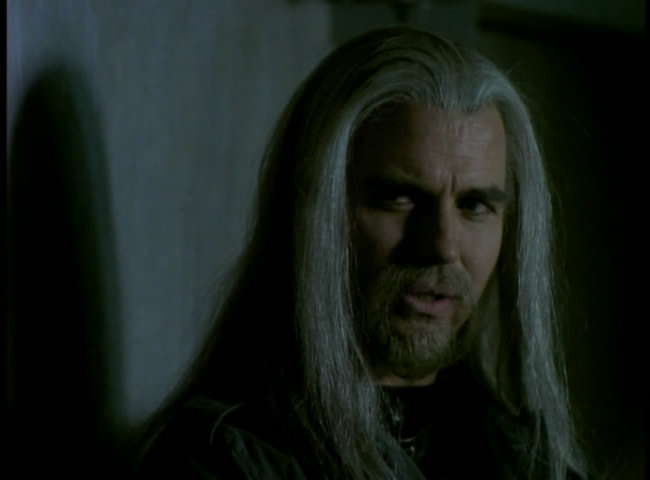
Johnny wakes up later to find that almost 20 years have passed, and that he is no longer Johnny Dalton – he’s a clone. Now referred to as “Johnny 2.0,” Johnny’s memories extend only to the injury 20 years ago when he had a scan of his memory. Now, the earth has become a dystopia, where countries have broken down, and only the corporations exist to maintain order. Worse, the “real” Johnny Dalton has either been taken by terrorists, or worse, has joined them, and has taken all his research, including a software program that removes imperfections in clones. Now, unless Johnny 2.0 can find and return the original Johnny Dalton, his body will start to break down within the week!
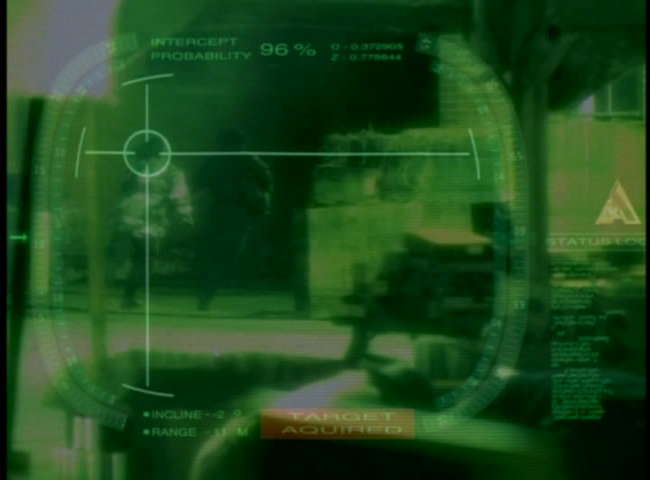
While the story starts off in an interesting way, and generally keeps a decent pacing, as things get tense, instead of resolving things in an innovative way, the viewer is continually assaulted with the most extreme plot twists. OK, one or maybe two might work, but Johnny 2.0 just doesn’t know when to leave well enough alone. Worse, in key scenes the rationale for certain characters starts to resemble the massive space invasion force surrounding Naboo in The Phantom Menace – they all seemingly took a lunch break when the counter attack came, leaving only one ship to defend their forces. When all is said and done, it’s simply not possible to suspend disbelief.
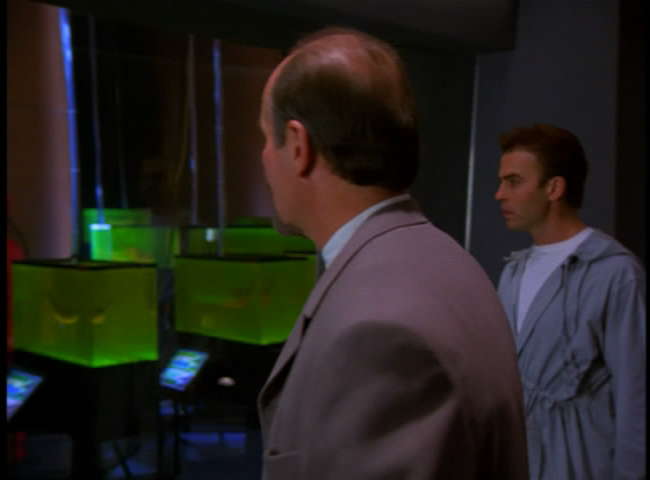
Johnny 2.0 Clone Technology Musings: For all its faults, Johnny 2.0 does have some interesting musings about cloning. The idea that clones can be sped up, and enhanced (by removing eye imperfections, improving the immune system, etc.) is interesting. More interesting is the idea that our memories can be recorded and re-inserted into a new host. Unfortunately, Johnny 2.0 doesn’t address idea with any degree of thought. In Johnny 2.0, the brain is essentially seen as an empty hard drive just waiting to be filled up with new memories. Even existing people apparently can have their memories wiped and re-inserted with new ones. Had this technology been combined with the rapid growth process, whereby a clone could be created while having their brain slowly become adapted to the imprinted memories, this would have worked lots better. Unfortunately, shortcomings in the ending narrative precluded anything unique here.
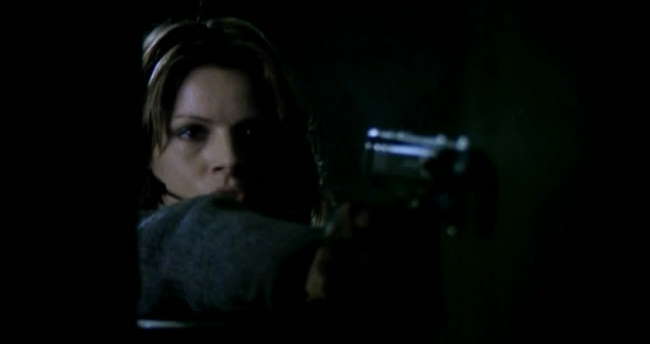
Even with the faults, Johnny 2.0 poses an interesting idea – that our existence could be perpetually extended by a combination of cloning and brain scanning. In Johnny 2.0, it’s the evil corporate head who is trying to cheat death, but if such a technology were created, one can only imagine the change we see in society. Imagine the chances we individually would take.
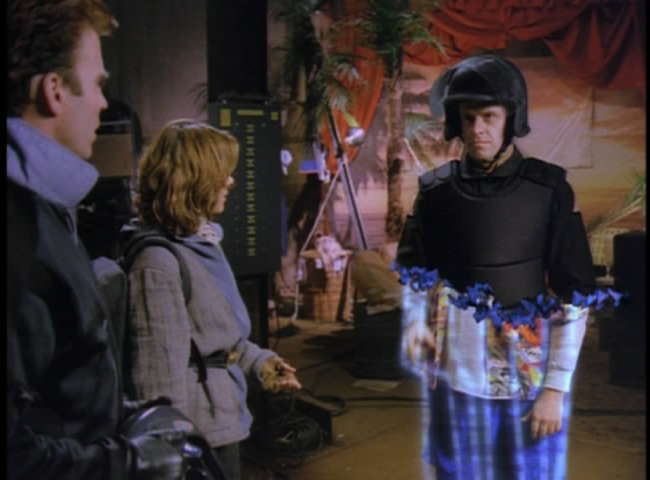
The FX: For the most part, the FX was what you’d expect – low budget TV fare. It wasn’t too distracting though, and pretty much worked for what was intended. Some of the effects, like the force field walkthrough scene was pretty forced though. One wonders why they would spend the money for a high-tech force field instead of a wall, especially when it can be penetrated so easily. They also seemed to try to stick VR helmets on everyone – this is more a sign of the times as VR stuff was hot in the mid nineties.
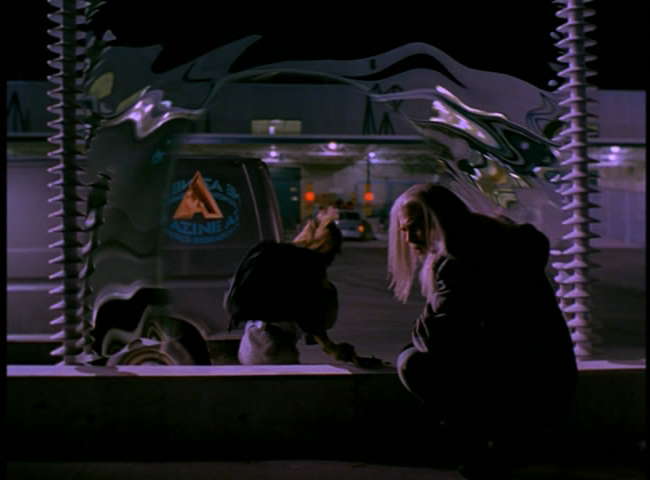
The Bottom Line: While the concept is interesting, this made for TV movie is poorly implemented. Although, there is enough here to get a modicum of enjoyment, and the movie does start off well enough that I feel compelled to give it at least a 5 star rating, especially considering it’s low budget. The actors were at least adequate (Michael Ironside of Total Recall fame was definitely the best of the bunch), so consider giving it a watch if nothing else strikes you.
~See movies similar to this one~
Movie Review By: SFAM
Year: 1993
Directed by: Sumiyoshi Furakawa
Written by: Yasushi Hirano (story), Kazumasa Hirai & Jirô Kuwata (characters)
IMDB Reference
Degree of Cyberpunk Visuals: Low
Correlation to Cyberpunk Themes: High
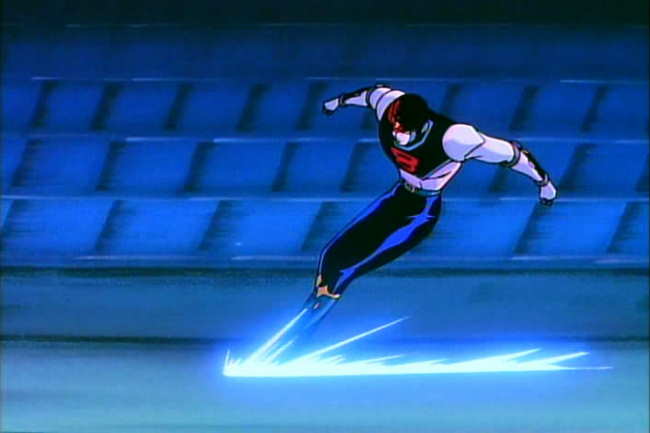
Overview: If you’re hankering for a sequel to Robocop, skip the live action sequels, and instead get 8 Man After. You won’t get the best animation, but the story itself is more than passable. The characters aren’t all that deep, but they’re interesting enough to keep your attention. This OVA, which on the DVD is presented as a film, seems to rise above the obviously meager animation budget to produce a decent product.
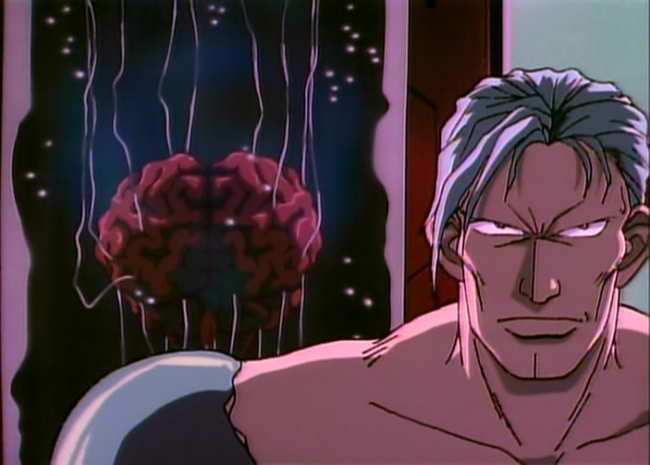
The Story: 8 Man After is a sequel to the 1960s TV series called 8th Man (I have not seen the original). In 8th Man, a cop dies, is revived, and is given a cybernetic body that can move lightning fast. He uses it to confront a cyborgs crime lord in similar circumstances, but is later killed. His girlfriend, Sachiko Yokogawa, never learns what happens to him. Since then, petty criminals with cybernetic implants have started to rule the streets. The police are outgunned, and decide they need a special edge – so they decide to revive the 8 Man.

In 8 Man After, a similar situation occurs as in the original – this time, police detective Hazama Itsuro, an emotionally fragile cop, meets up with Sachiko on a chance encounter, and they begin to fall in love. But fate intervenes, and a nasty criminal with cyborgs implants comes to kill them. Hazama is able to defeat him, but seemingly dies in the process by falling out of a high story window. Hazama is revived when the police take Hazama’s brain and insert it into 8 Man’s body.
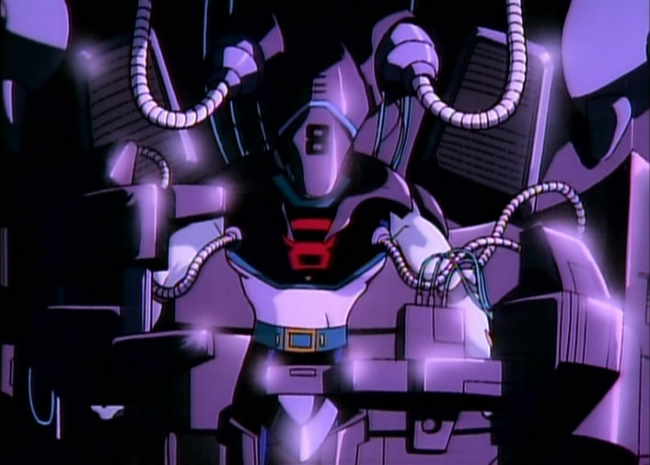
Hazama can now move lightning fast, and due to technical reasons, is the most advanced cyborgs on earth. He begins to fight the bad guys, but unfortunately, it turns out that his emotional troubles cause him to occasionally lose control over his actions. This is complicated by Hazama’s continuing relationship with Sachiko, who does not know what he’s become. Things come to a head when Hazama/8 Man goes up against the crime lord while trying to rescue Sachiko.
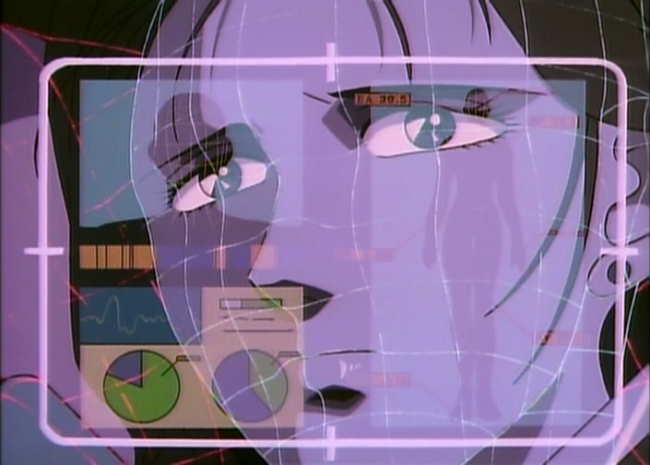
This is a “Who am I?” Story: 8 Man After does a decent job of going over established ground in that it questions whether a brain inserted into a cyborgs host is still human. The complicating twist in 8 Man’s case is that his emotions end up making him temporarily lose control over his body, and in fact, lose awareness over certain events. The added relationship aspect, where Sachiko has now fallen in love with two people who end up losing their bodies is sort of interesting as well. Again, there’s nothing really new here, but it is well done.
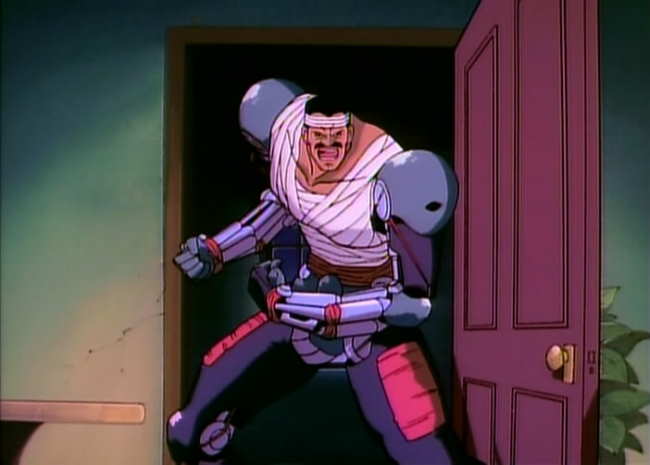
The Animation: At some level, animation of this quality, five years after Akira is surprising. Many of the shots look like straight Saturday morning cartoon fodder. Every now and then, we get a terrific shot or two, and sometimes get an innovating looking camera approach, but for the most part, you get simplistic backgrounds, very basic character designs, linear movement, and lots of pan and scans of stills. Worse, you also get some repeated 8 Man after streaking shots. Without an absolutely kickin story (which it has), 8 Man After just wouldn’t be worth the time.
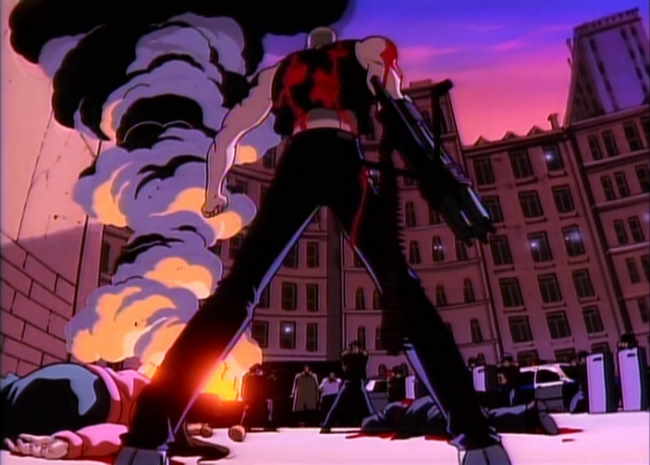
The Violence: Like Robocop, 8 Man After is very violent. However, the animation isn’t good enough for this to really matter all that much. There is lots of blood and killing which is usually don’t in the context of a motivating story, but it just doesn’t have the impact of many violent animes. Even if you can’t stomach violent story lines, you will probably be OK with 8 Man After.
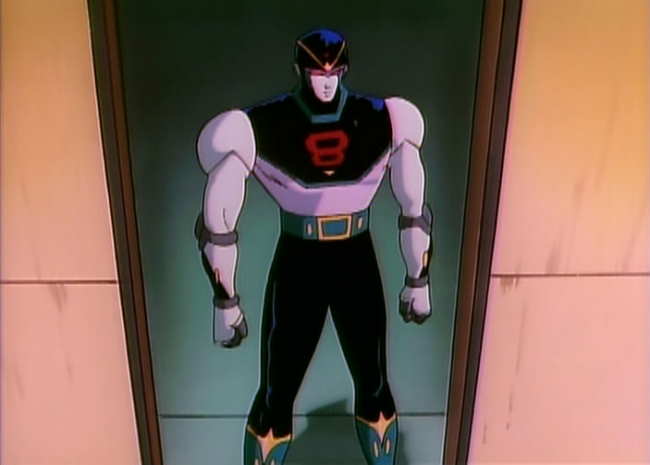
The Bottom Line: OK, the animation isn’t the greatest, but the story is pretty good – FAR better than the Robocop sequels. The sub-plot of the son with a burnt-out cyborg father is especially well done. If you’re looking for a Robocop-like examination of humanity, animated from the cyborg’s perspective, 8 Man After is a decent choice.
~See movies similar to this one~
Movie Review By: SFAM
Year: 1995
Directed by: Peter Chung & Howard Baker
Written by: Peter Chung et. al.
IMDB Reference
Degree of Cyberpunk Visuals: Very High
Correlation to Cyberpunk Themes: High
Key Cast Members:
Æon Flux: Denise Poirier (voice)
Trevor Goodchild: John Rafter Lee (voice)
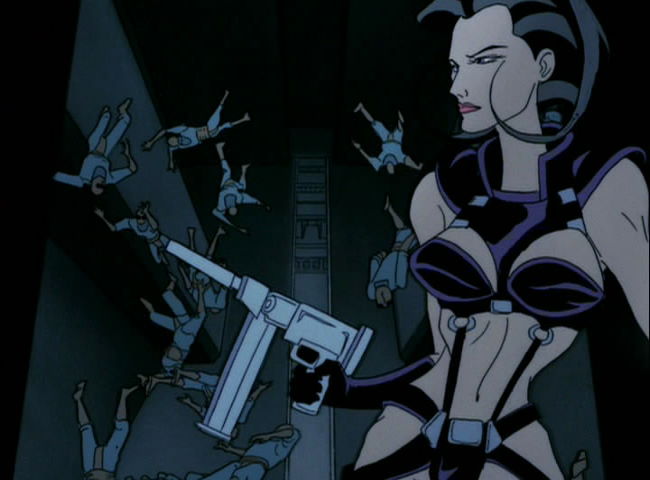
Overview: Aeon-Flux, the brainchild of Peter Chung (also the writer/director of the terrific Animatrix short, “Matriculated”), is one of the really innovative and unique animated shows to come out of the United States. We really have to thank MTV for allowing this show to get produced, and then, after realizing that they just couldn’t control it, for letting it go on unfettered for a second season. Aeon-Flux is not meant to be a coherent whole – this postmodern cyberpunk show is as nihilistic as they come.
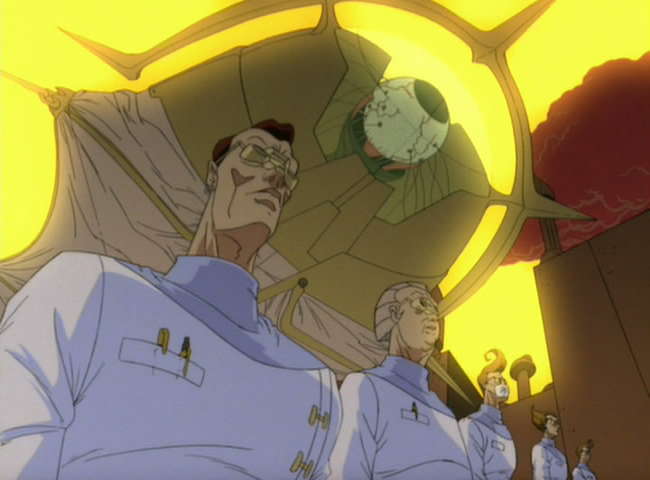
The Story: Aeon Flux takes place in a truly bizarre near-future setting, in which genetic engineering, body modifications, and excessive self-gratification are the norm – yet these extremes take place in a controlled surveillance society. Nearly all events take place in the utopian city, Bregna, which is controlled by a supreme oligarchy. Trevor (voiced by Vampire Hunter D’s John Rafter Lee), one of the two central characters, is a prototypical mad scientist who, at first seems to have little regard for anything other than his own perverted desires. As the show goes on, we find that he is in fact truly besotted with Aeon Flux, who, in many ways is his complete opposite. Aeon Flux (voiced by Denise Poirier) represents the forces of anarchy, and is continually involved in fucking up Trevor’s carefully laid scheming. Unfortunately for Aeon, she too cannot resist Trevor’s guile, which just as often, leads to her downfall.
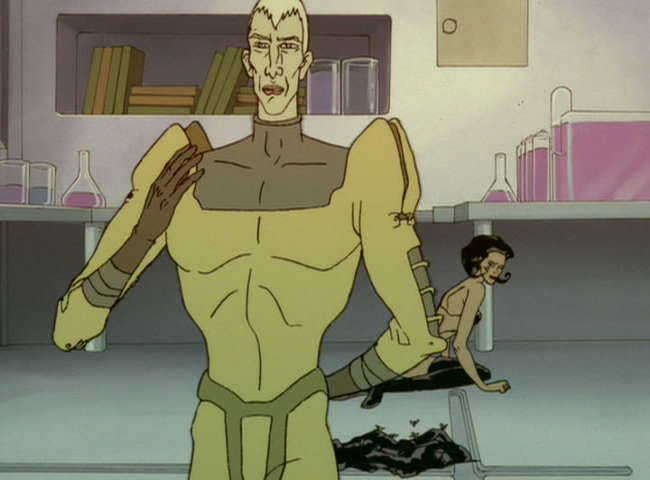
Virtually every episode is different in Aeon Flux, but all of them deal with a strange, fast-paced plot that deals with espionage in some way. Episodes usually have the feel of a chess match, where Aeon and Trevor match wits over completely strange and esoteric plots. More often than not, nobody wins. In fact, unlike most shows, the winning and ending itself is rarely important. This is not what the shows are about. More important is the mood, the feel, and the atmosphere that exudes from the visuals, the dialogue and the score.
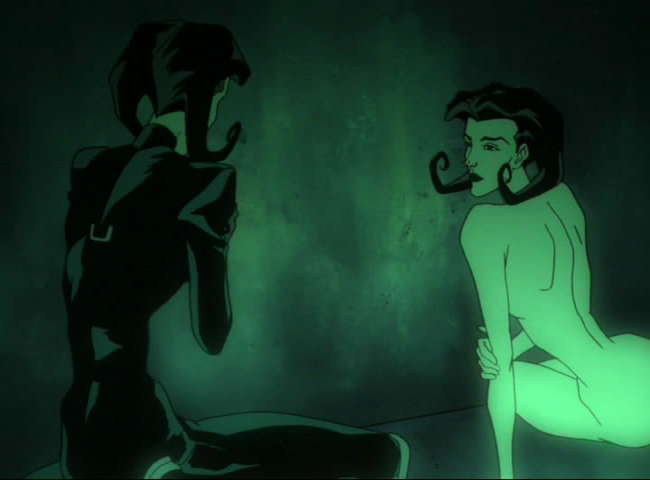
Spoiler – Aeon Flux Dies…A lot! Well, OK, it’s not really a spoiler. It’s more a fact of the show itself. Unlike most shows, in this one, the star dies regularly. Early on in the long shows, Trevor clones Aeon Flux, so thematically, there is now an infinite number of Aeons just waiting to bite the big one. And while there’s now a “rationale” for the deaths, this isn’t really the point – Aeon Flux isn’t meant to hold together that way. It’s almost as if each episode is completely it’s own show. But if she dies, rest assured it will happen in a truly innovative and gruesome way. It could be drowning in a vat of poisen, getting dropped out of a plane, being eating by bizarre genetically modified creatures, or, well, you get the idea. .

Aeon Flux – the Ultimate Anti-heroine? In many ways, Aeon Flux comes across as the ultimate anti-heroine. While she clearly knows right from wrong, and generally tries to stop the worst abuses, Aeon is an ultra-acrobatic, top-notch action/espionage heroine who works for herself. She’s just as likely to take an assassination job as she is to stop a horrid virus from killing mankind. Did I mention she’s drawn up in ultra-hot, skimpy clothes, and likes to have sex a lot? In this way, she really does qualify as a more female than female character (usually cyberpunk reserves these for cyborgs and androids). Most interestingly, because of Aeon Flux’s propensity for dying, you never know whether or not she’s going to make it through alive, or even whether she’ll complete her mission (she seems to fail almost as much as she succeeds). This really does add an excitement to the episodes.
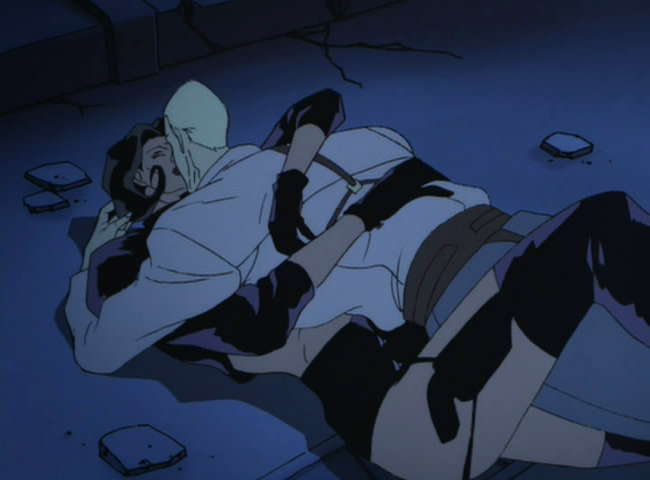
The Love-Hate Relationship: Aeon-Flux and Trevor have a complete love-hate relationship. Even when they are bent on killing one-another, there is always sexual tension, which while often consummated, never leaves the two characters. Every episode gives us yet another chance to explore their relationship in a completely bizarre way. Trevor is definitely Aeon’s Kryptonite. More often than not, his presence alone is enough to make her botch her mission. However, this doesn’t stop Aeon from ruining most, if not all of Trevor’s take over the world plots.
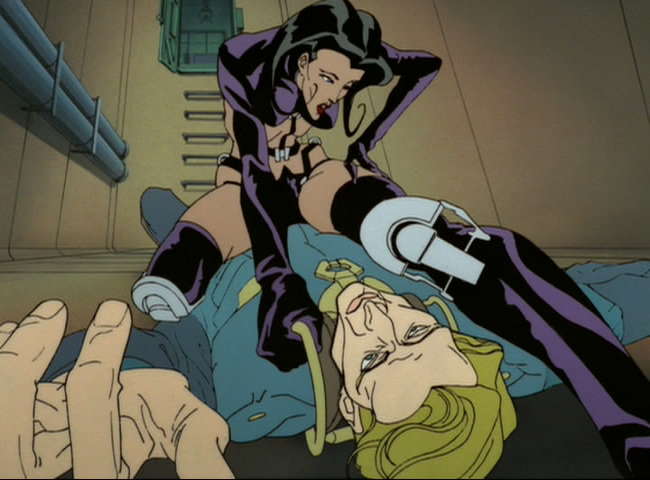
The Visuals and Cinematography: Aeon Flux gives a number of different looks as the show progresses. Perhaps my favorite are the perspective shots such as the one above. We also get lots of wide angle shots, strange close-ups, gradients, and a number of truly surrealistic sets. Unlike most cyberpunk, Aeon Flux doesn’t really adhere to a single dominating color scheme – but to the extent it does, the blues are more highlighted than the rest. Usually, each episode will have a unique theme that dictates the color choices – often they will take a color palette (oranges, greens, etc.) and detail it out in interesting ways. Some episodes are truly surreal in nature, while others are straight neo-noir. The overall goal is always to innovatively create a far-out intense atmosphere wrapped up in a tightly paced, no-nonsense near-future espionage show. More often than not it succeeds.
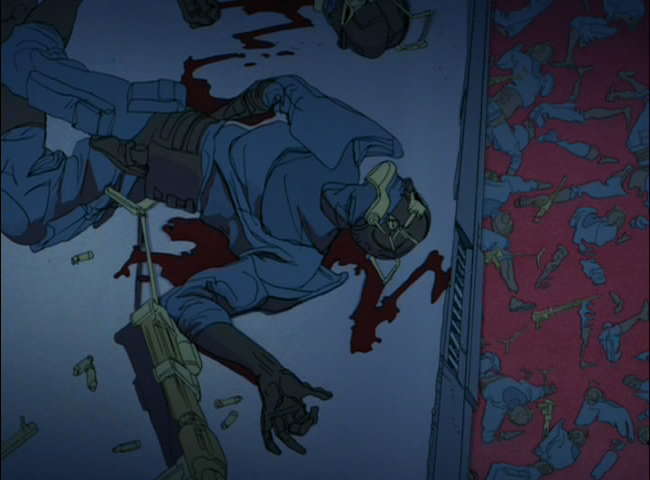
The Violence: Much to MTV’s initial chagrin, Aeon Flux is NOT a kids show. This is an adult cartoon in every way possible, including the intense violence. While the shorts are more violent than the half-hour episodes, Aeon Flux is consistently violent. There are leg amputations, deaths by gunshot, poison, insects, creatures, aliens, viruses, et cetera (often to Aeon herself!). Blood and gore are often just a scene or two away. All of this serves to strengthen the near-future but otherworldly atmosphere of Aeon Flux.
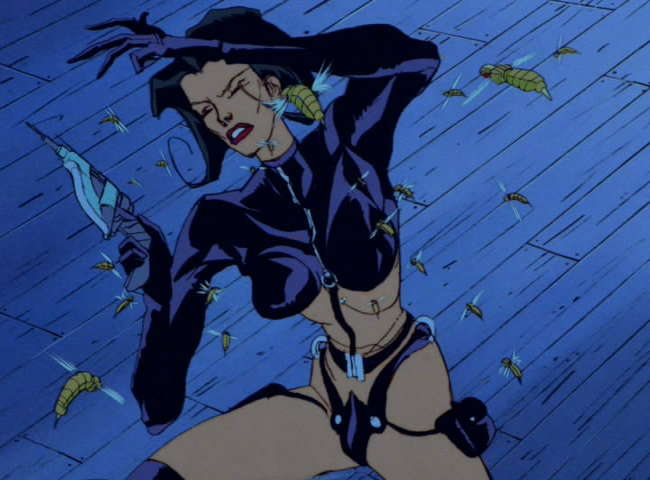
The Gadgets: Aeon-Flux is filled with gadgets of all flavors. Most common are body modifications and “biopunk” elements (just learned that word ). Body modifications include external spinal cord implants, leg jumping implants, conversions of limbs, eye implants, and various compartmentalized bodily storage areas. Genetic engineering is a huge theme in Aeon Flux, far more than the cyber-aspects. We also see repeated instances of cybernetically modified insects who’s function is to inflict a virus of some kind into a target population (Now we know where DARPA got the idea from!). Needles are also a recurring them, and show up everywhere from guns, to security implements, to, um, the operating table.
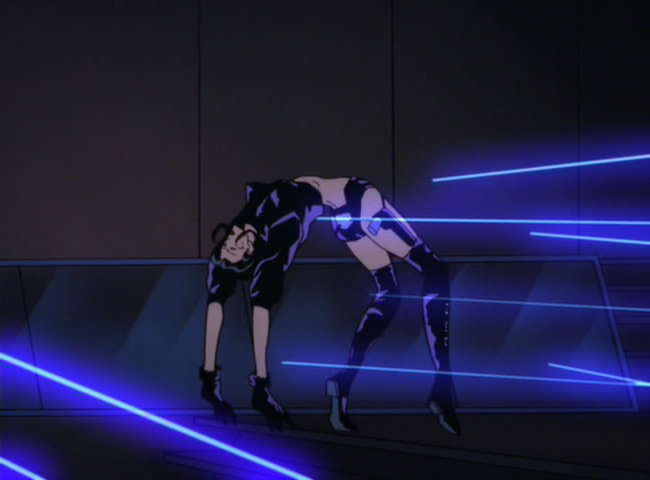
The Bottom Line: Aeon Flux is one of the really creative shows to come out of United States Television. This show validates the purpose of cable TV – we get to see talented folks like Peter Chung let lose their creative energies to produce something truly unique. And while I normally don’t spend too much time talking about the DVD features, I must on Aeon-Flux – the DVD set is flat-out terrific. I almost put it up there with Errol Flynn’s Robin Hood and The Kino edition of Metropolis as one of my favorite DVD productions of a long-lost show. The commentaries, featurettes, and extras are all terrific on the Aeon Flux DVD. If I had any qualms about whether to give Aeon Flux 8 or 9 stars, the incredible quality of the DVD set answers it for me.
More Aeon Flux Screencaps on Page 2–>>
~See movies similar to this one~
Movie Review By: Metatron
Year: 1998
Directed by: Rob Bowman
Written by: William Gibson & Tom Maddox
IMDB Reference
Degree of Cyberpunk Visuals: Medium
Correlation to Cyberpunk Themes: Very High
Key Cast Members:
Esther Nairn/Invisigoth: Kristin Lehman
Fox Mulder: David Duchovny
Dana Scully: Gillian Anderson
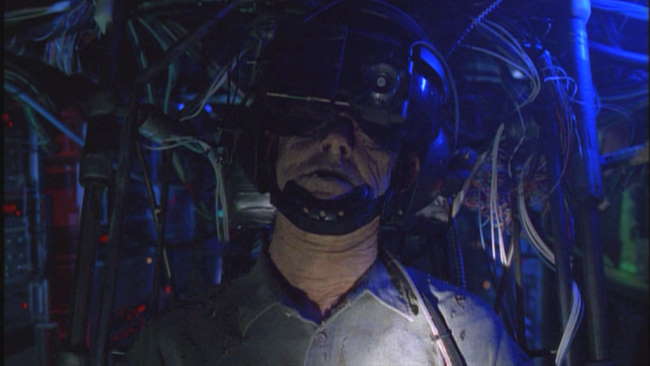
This is what happens when you forget there IS a real world outside…
Overview: Now, surely there must have been some kind of mistake. This is Cyberpunk Review, right? OK. Since when stories of little green men do qualify as such? Surely the mere fact that agent Scully had an implant in her neck does not count for an awful lot.
All true. This particular episode, however, is different. Look at the credits. William Gibson. Ring any bells?

More Than Meets the Eye: It all starts with a rather innocuous shootout at a diner in a drab neighbourhood. Piece of cake, eh? Well, not exactly, as it turns out that one of the victims is in fact a top IT expert and programmer whose death might have been anything less than a coincidence. Soon afterwards Mulder and Scully happen upon a rather charming lady going by the nick-name of Invisigoth, who turns out to be much more than just a leather-clad Trinity wannabe…
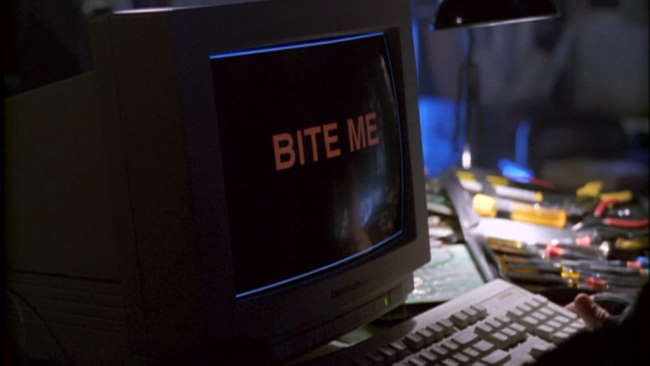
The threat, it is revealed, comes from a fugitive AI she and her companions helped to spawn. This synthetic entity seems to have little regard for human life, plus it possesses some rather eccentric habits, such as playing with leftover Star Wars military orbital lasers and residing in abandoned… camping trailers. Needless to say it has to be stopped, although it may yet turn out Invisigoth pursues a different agenda altogether…
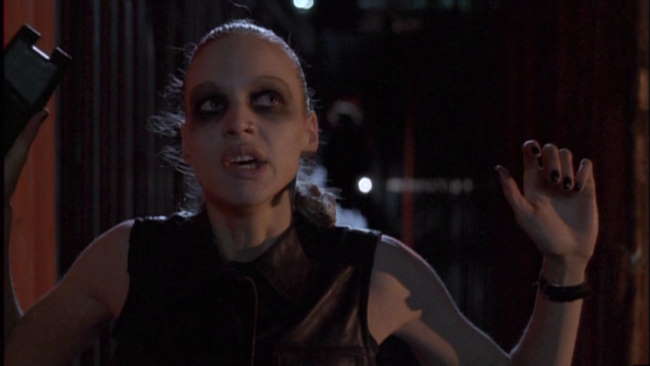
“Okay mom, I did actually use your eye-liner…”
Out There: Even if the credits said “Jay Leno” or “Kermit the Frog” rather than Gibson, there still would be a good case to make for the overall cyberpunk feel of this standalone episode. In terms of themes, it is all there- the pursuit of the AI takes place both in our very own “desert of the real” and through the net; agent Mulder even gets to become a multiple amputee courtesy of the malicious program’s VR simulation. More interestingly, the episode deals with the transfer of consciousness- translating a human psyche into digital data in pursuit of a peculiar kind of disembodied immortality. It is at that point one may begin to realise that one of the foremost attractions of the concept of sentient cyberspace entities is that cyberspace begins, to the mind of many, resemble a manufactured heaven of sort, a synthetic paradise for the unbelievers, allowing those of little religious zeal to dream of achieving transcendence. This move to another plane of existence, an ersatz afterlife- may not be explored at lengths here, yet gives a good cause for reflection. Apart from the sentient computer theme there is of course our sweet little Trinity impersonator (prettier than the real deal? I might be getting controversial here…) who also happens to drive a car (1960s Imperial, to be exact) very similar to the black Lincoln in the first Matrix.
Convinced? And then you realise that this episode actually comes from 1998, which is a year BEFORE tha Matrix… So, who’s the copycat, eh Trinity? Guess I should be expecting a lawsuit for these allegations any time now…
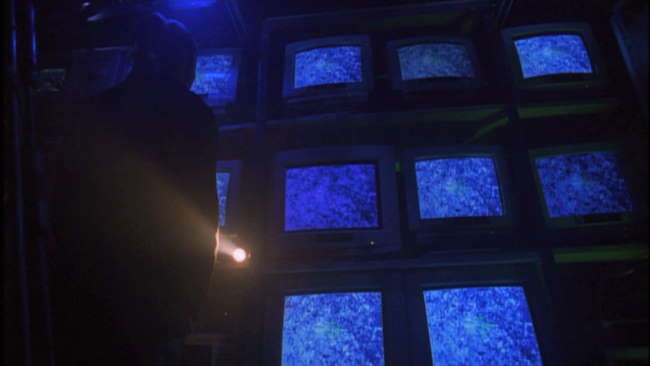
The Visuals: While not trying to rival Blade Runner, the visuals are decent for the budget. Being that this is an X-files episode, we shouldn’t expect anything too fancy - the series rarely relies on fancy visuals to generate their mood, or to depict story elements. One of the distinct traits of the X-Files is that they can often make ordinary places or events appear menacing and sinister when placed in the given context - this applies to Kill Switch.

I assure you that, having seen this episode, the next time you’ll see a decaying camping trailer you’re gonna think twice before approaching it. In a way this depiction of cyberpunk is more realistic - inconspicuous locations concealing the drama of furtive technological experiments and computer crime is very much what one’s bound to encounter today. The most important bit - the flow of data - is hidden from the eye. The episode does treat us to some juicy cyberpunk visual elements, including gloomy improvised computer labs, and chaotic nests of cables and wires lit by the dim glow of terminal screens - but nothing too extravagant (aside for a few explosions).
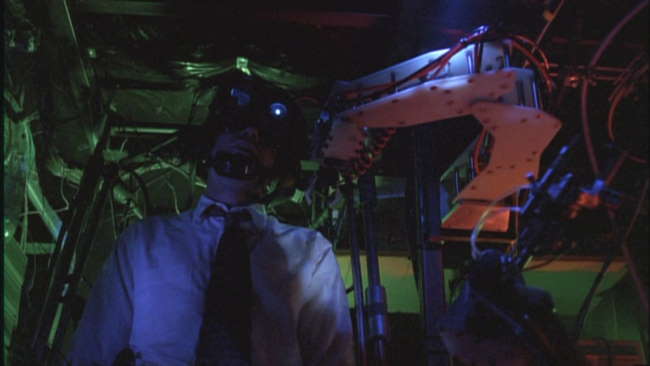
Confirm File Delete: Overall the episode represents a truly interesting foray of the famous franchise into the realms of cyberpunk, courtesy of Mr. Gibson himself. As with many other episodes, the strength of Kill Switch lies in its inherently believable narration, a mixture of the ordinary and the imaginary that made the series famous. The acting is decent- Invisigoth oozes character- and the action tightly coiled into a mere 45 minutes of film. Yet because of the unspectacular nature of the whole thing few will probably have seen and noticed it, even if this is as close as we can get into having a Gibson story made into a feature film, after his Alien3 script got binned long ago. It may not be cyberpunk canon in any way, but do watch it- I swear that after those 45 minutes you’re likely to be craving for more. Which you just might get, as there is another Gibson-written X-File which I will investigate soon…
~See movies similar to this one~
Tags: TV episode review
Year: 1993
Directed by: Hiroshi Fukutomi
Written by: Yukito Kishiro (Manga), Akinori Endo
IMDB Reference
Degree of Cyberpunk Visuals: High
Correlation to Cyberpunk Themes: Very High
Key Cast Members:
Gally (Alita): Miki Itô
Ido: Kariya Shunsuke
Yugo: Kappei Yamaguchi
Chiren: Mami Koyama
Vector: Shigeru Chiba
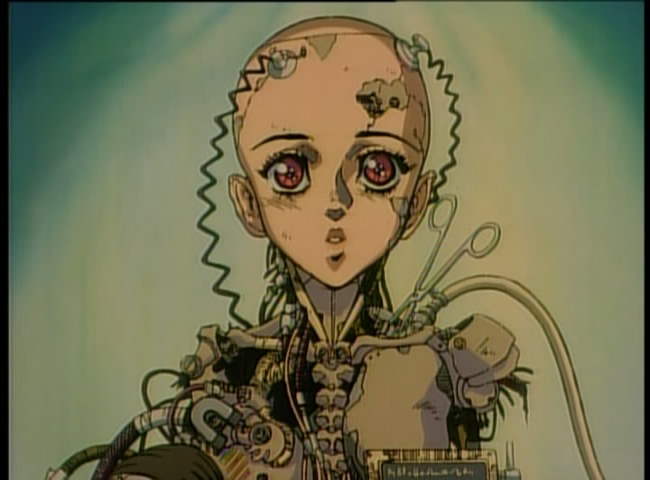
Overview: Battle Angel is based off a very well done Manga series called Battle Angel Alita. The movie covers the first two volumes of the Manga: Rusty Angel, which documents Alita’s “rebirth” and Tears of an Angel, which portrays a tragic love story. This anime from 1993 is one of the best man-machine interface animes out. The story is solid, and the drawing for that time period is terrific. While you might hear some gripe that the Manga is better, I think Fukutomi did a terrific job in taking Kishiro’s story to anime. I can only hope that James Cameron does a similarly wonderful job with the upcoming live action version of this. Just a warning - this is not a kids story - it contains lots of blood, head removals and minor amounts of nudity.
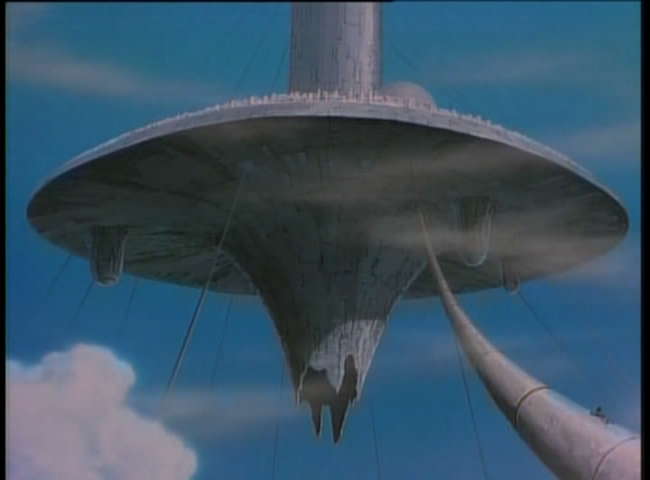
The Setting: Battle Angel takes place far into the future, after a societal collapse has occurred. Advanced human society has been relegated to a floating city called Zalem, that sits above a refuse heap called Scrap Iron City, which is inhabited by denizens living off the scraps and waste products Zalem expels. A corporation called the “Factory,” the primary employer for Scrap Iron City, sends products back up to Zalem through a series of huge metal tubes. Cyborg technology has become a way of life, with many “humans” having only their brain remaining from their original human body host. Scavenging and theft has become a way of life for many. Backbones are a particularly sought after commodity by thieves, who sometimes will violently take them from their living hosts. As social services no longer exist, the Factory posts “bounties” for the heads of the most egregious villians, which bounty hunters, called Hunter-Warriors pursue for money.
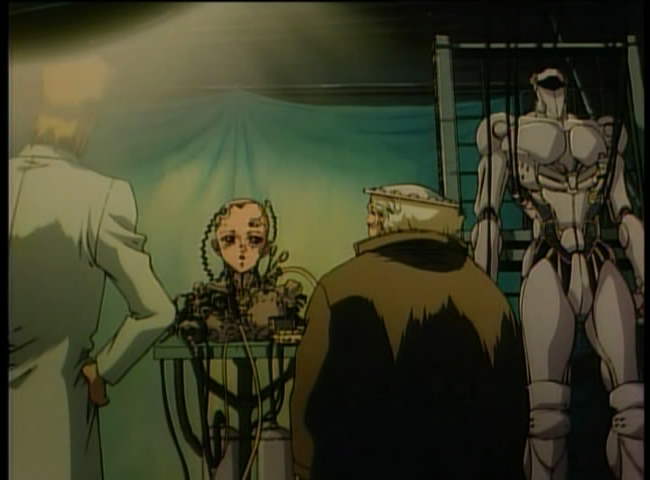
Rusty Angel: Daisuke Ido, an cyborg doctor extraordinaire, former citizen of Zalem, scavenges through the refuse heap to find spare cyborg parts to repair the citizens of Scrap Iron City. One day he comes across a female cyborg head that has a still-living human brain in it. He sets out to repair this head and gives her a wonderful body off of parts he has collected. He names her Gally (she is called Alita in the Manga), and she seems totally restored, except for the loss of memory from her earlier life. Ido becomes attached to Gally and they quickly develop a father-daughter type relationship.
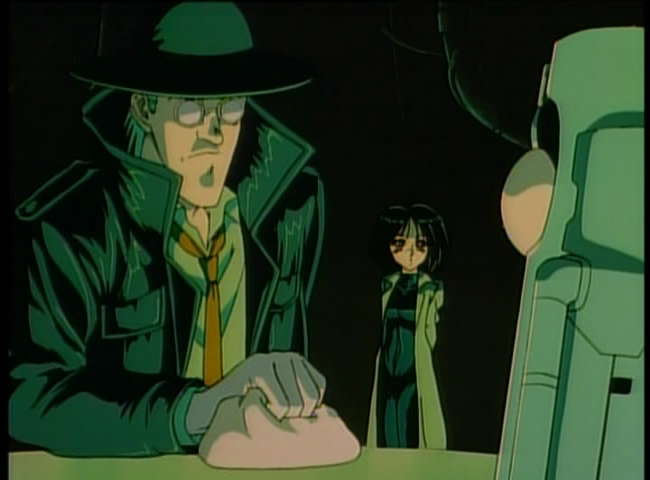
Gally learns that Ido moonlights also a Hunter-Warrior both for moral reasons and to support his medical practice. Gally saves Ido from certain death, and thus, reveals that she, in her former life, was also a very talented warrior. Under protest from Ido, Gally asserts her individuality and desire to become a Hunter-Warrior like Ido, so that she too can have purpose to her life.
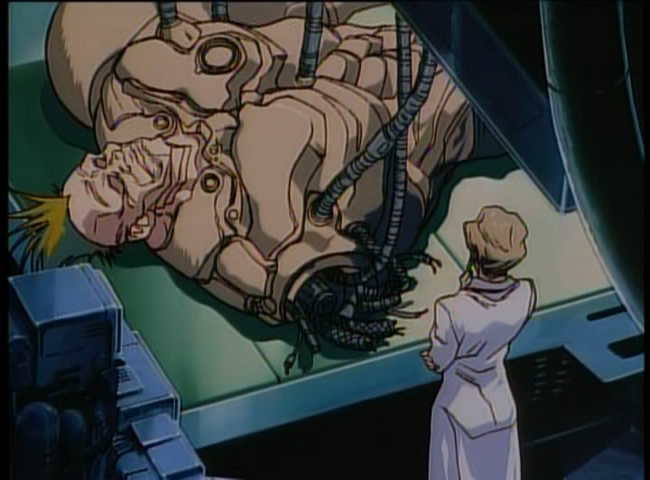
Chiren, also a cyborg doctor and Ido’s former partner, has also been ousted from Zalem, and is consumed with finding a way to return. Deciding that she will do anything to make this happen, Chiren hooks up with Vector, a shady character who has connections with the “Factory,” who agrees to eventually take her to Zalem in return for sexual favors and for her assistance in building a supra-cyborg gladiator named Greweicia for the fighting ring. This cyborg warrior also has a penchant for eating brains, and ends up on the bounty list. Chiren, wanting to be seen as superior to Ido, gets Greweicia to fight Gally in the hopes of destroying her, and thus, destroying Ido.
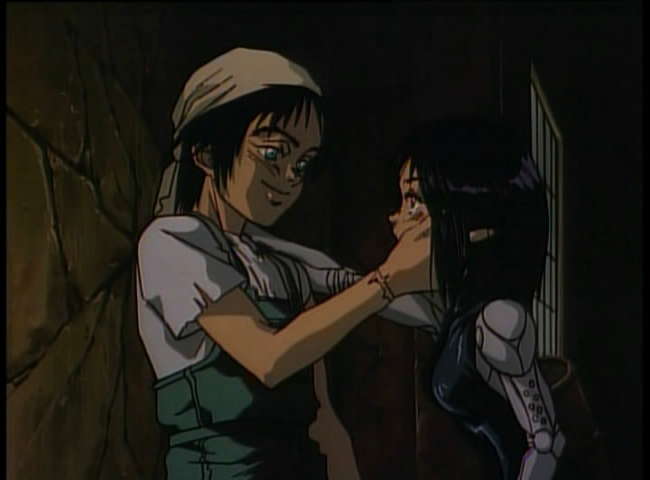
Tears of an Angel: Gally, in exploring the city has become infatuated with a hard working body named Yugo, who dreams of going to Zalem. Although it’s common knowledge that nobody born in Scrap Iron City can ever go to Zalem, Yogo is also consumed with finding a way, and has gotten an agreement from Vector, who promises Yugo if he can make 10,000,000 credits, than he will take Yugo to Zalem. Yugo has taken him up on his offer and has started stealing cyborg spinal cords as a way to augment his day job of fixing machinery. He is discovered, and is put on the Bounty list. Gally, who has fallen deeply in love with him, tries to rescue him from a rival bounty hunter. Unfortunately she is too late, but is able to save his head, and asks Ido to turn him into a cyborg. Even after becoming a cyborg, Yugo’s dreams of reaching Zalem cannot be abated, as he sees his life a struggle against the worthlessness that is the Scap Iron City.
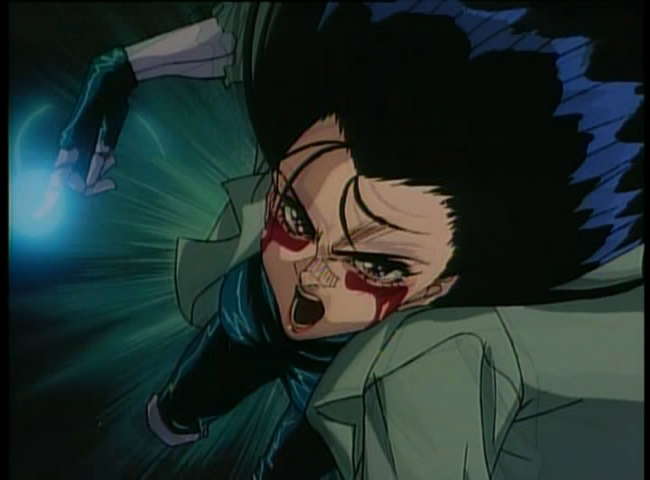
The Artwork: In Battle Angel, we see strong influences of Akira in most every aspect of the production. From the facial expressions to the darkly textured backgrounds to the fighting style approach, Battle Angel clearly has used Akira as a template for modern animation techniques. Like many OAVs of this time period, some of the backgrounds are bland while others are lavishly penned and inked with multi-layered designs. They “pick their battles” with the designs, but for the most part, the decisions are solid. The simple designs are in backgrounds such as the sky and in Ido’s house. The more complex ones are in the underground, Yugo’s hang out, and in the refuse heap scenes – this is where most of the action and plot take place.

Changes from the Manga: While I think Battle Angel is a terrific anime, there are some changes from the Manga that some find annoying. Most bizarre is the renaming of Alita to Gally, and the city Tiphares to Zalem. However, unlike some, I don’t find the changes in the plot to be that problematic. The anime wonderfully captures the essence of the Manga. Perhaps the biggest change is the rationale for Alita’s powers. In the anime, we really don’t get an explanation, but in the Manga, Alita is first given a normal body by Ido, and ends up destroying it in her first fight. Realizing that Alita is a warrior at heart, Ido gives her the body he has saved for a long time – that of a berserker warrior. The primary villain in Rusty Angel is also different – he is a being who has grown up in the sewers, and after losing his body in fighting Alita, he takes over the Gladiator’s body. And Chiren, a central character in the anime is not in the first to novels of the Manga. Again, for the most part, I have no problems with the changes, and actually love the dimension that Chiren adds.

The Bottom Line: Battle Angel (Alita) just works for me as an anime. It is intelligent enough and well enough executed to get you to imagine a world where cyborgs are a reality. The world from the underground perspective is well done and Alita (I call her Alita, not Gally) as a character is terrific. Along with Armitage III and Ghost in the Shell (obviously), Alita is one of the best animes of this kind. Just a caution for those who have only seen the VHS, like most Japanese animes, Battle Angel comes off FAR FAR better with the Japanese dubbing cast than it does the English cast.
~See movies similar to this one~
Year: 1987
Directed by: Shirow Masamune
Written by: Shirow Masamune
IMDB Reference
Degree of Cyberpunk Visuals: Medium
Correlation to Cyberpunk Themes: Medium
Key Cast Members:
Sybel: Yoshiko Sakakibara
Ferris: Chisa Yokoyama
Dr. Matthew: Ichirô Nagai
Col. Arthur: Shinji Ogawa
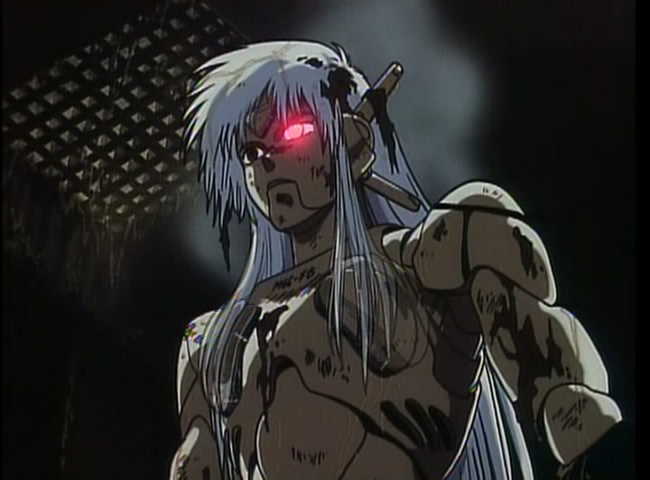
Overview: Masume Shirow’s Black Magic M-66 is one of the best Terminator anime clones. Most know Masume Shirow from his Appleseed and Ghost in the Shell Mangas, not to mention his myriad of other hot chicks kicking butt artwork (Intron Depot Ballistics is my favorite). Black Magic M-66 is his first anime. The visuals, while quality, are definitely 80s cartoon style.

In this “When Good Fembots Go Bad” tale, a tough and sexy journalist who likes to hang out in the buff picks up a military transmission on her scanner about an escaped weapon system. In her haste to get the story, she almost forgets to put on clothes, but finally comes back for a pair of pants. She eventually tracks the military to the woods and finds them besieged by an android weapon accidentally “turned on” after a horrible cargo plane crash.
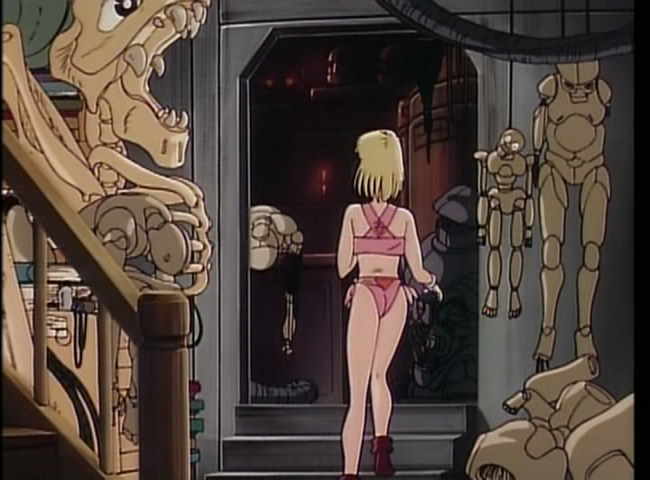
This android chick is ultra-tough, nearly unstoppable, and, due to it running on laboratory test data, apparently has been programmed to kill the inventor’s daughter. The reporter figures this out tries to rescue the android inventor’s daughter, but the M-66 is hot on her heels. All hell breaks lose in this anime, which is essentially a Terminator-style chase from beginning to end.

If you’re a cyber-studies researcher in need of a good example of cyberpunk’s propensity for objectification of women, Black Magic M-66 is your movie! You get a bevy of good stereotypes here, including the tougher than tough, smarter than smart, ultra-hot reporter who doesn’t like to wear clothes, the needy and continually fainting daughter always in need of rescue, and of course the M-66 weapon system - made in a woman’s image for God knows what reason (other than the obvious, of course). Again, this movie doesn’t bother you with needless philosophies that might confuse things - its all visual.
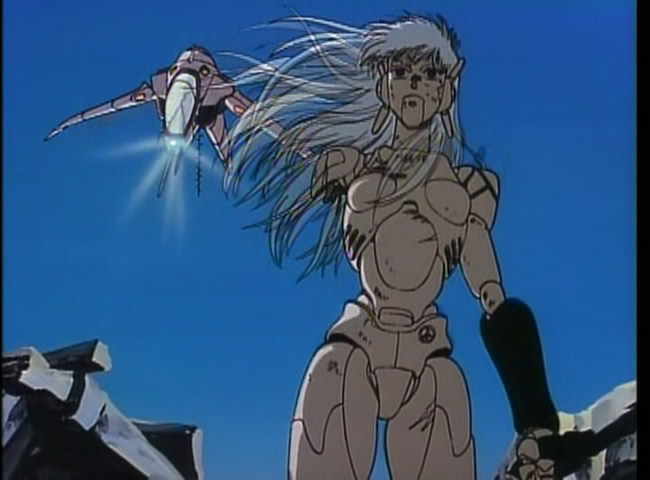
The Bottom Line: Black Magic M-66 does not have in-depth philosophical questions - its not that type of cyberpunk anime. This is an action-fest from the get-go. It doesn’t bother giving you lots of in-depth set-up or character rationales. The action is good though, and the pacing is consistently fast and tense, and generally goes fast enough for you to ignore plot holes and bizarre side questions like why was the inventor’s daughter in the target the “test” data. The anime is still 80s style, especially in the backgrounds, but Shirow always does fine quality products.
~See movies similar to this one~
Tags: cyberpunk movie review anime M-66
Year: 1994
Directed by: Alan Best et al.
Written by: Martin M. Borycki et al.
Degree of Cyberpunk Visuals: High
Correlation to Cyberpunk Themes: Medium

Overview: This is one of those shows that TOTALLY addicted me to it when it came out. This was the first 3D animation I ever saw, and I must say, I completely fell in love with it. Reboot is a wonderfully intelligent kids show, that for techies, seemed to have all the inside-tech jokes just right. All the characters are inside a computer world - the mainframe, and the good guys are trying to stop the evil virus, Megabyte from infecting the rest of the mainframe.

The Bottom Line: Reboot provided us a terrific fantasy view inside a virtual computer. While the first two seasons were fun, season 3 was just terrific! After ABC dropped this Canadian production, they were able to go adult-like, with much darker themes and a really cool sword and sorcery bent. The follow-on movies captured the fun of the first two seasons while keeping the darkness of the third. And while the CG has definitely been surpassed, for some reason, the look still works.
~See movies similar to this one~
Tags: cyberpunk movie review Reboot anime
Year: 1994
Directed by: Hiroyuki Ochi
Written by: Akinori Endo, Chiaki Konaka
IMDB Reference
Degree of Cyberpunk Visuals: High
Correlation to Cyberpunk Themes: Very High
Key Cast Members:
Armitage: Hiroko Kasahara
Ross Sylibus: Yasunori Masutani
D’Anclaude: Ryûsei Nakao
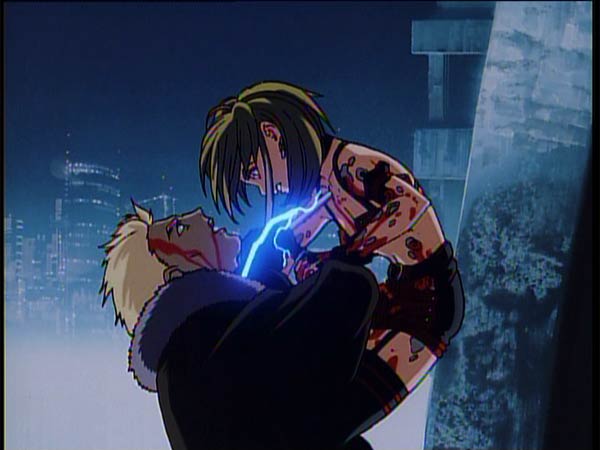
Overview: Armitage III, one of the many Chiaka Konaka written masterpieces (along with Serial Experiments Lain, Texhnolyze, Malice@Doll) is simply an awesome story. If you like Blade Runner and haven’t seen Armitage, you’re doing yourself a disservice. Most of the same issues are raised there, but are done in an original enough way that makes you absolutely love this little anime chick. Humanity as an exclusionary concept which also implies “worth” is fully explored here. Are androids still supposed to just be our servants even if they do have a sense of self-worth?
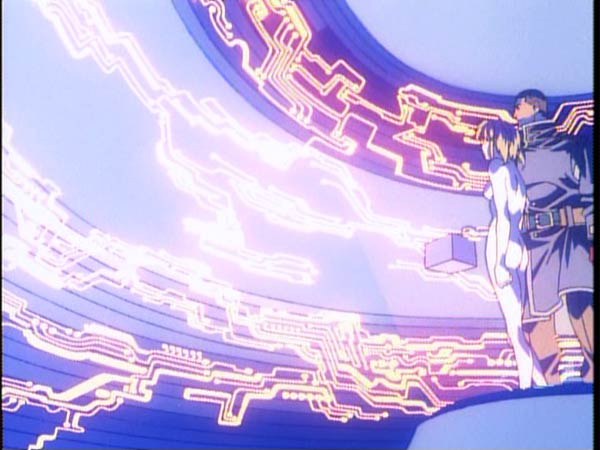
Set in a Blade Runner-like future, mostly centering on Mars, Naomi Armitage is a type III series android who works as a cop on Mars, along with her new partner, Ross Sylibus. While most of the public knows about, and barely tolerates the type II series, they are not aware that there are a few lifelike, human-acting type III series androids living among them. Unfortunately for the robots though, someone knows of their existence and is systematically killing them one by one.
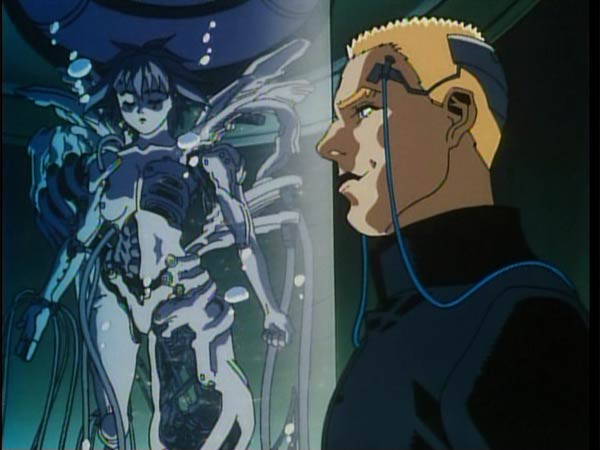
As the plot progresses, Ross, who doesn’t like robots (his former partner was killed by a cyborg) learns that Armitage is an android. Even worse, they learn that the murderer is a series IV robot. Armitage, who starts off as a wise-cracking, disrespectful cop who dresses in sleazy clothes starts to question her “humanity” such as it is. In addition to realizing she’s one of the very few left, Armitage wonders why she was ever created. As she struggles to maintain “sanity,” Ross begin to develop a closer relationship - one that is not too mushy, and works well with the pacing.

Armitage eventually broadens into a large-scale conflict that involves greedy corporations, inter-galactic disputes, android’s rights, population issues, and all the rest. We get LOTS of gun fights in this, and even a full scale battle, mecha style. In addition to being cute and vulnerable as an android wondering if she has a purpose in life, Armitage also kicks major ass in her burgundy leather ensemble. Guts, martial arts and all sorts of other gadgets come flying out of this chick. She is definitely, tough, strong willed, and lots of fun to watch.

Notice the incredible similarity to another futuristic building in Metropolis.
The story is one of the most compelling in cyberpunk anime and really makes you feel for Armitage. Yes, the whole questioning of humanity by an android has been done before (and since) and since, but Armitage is definitely one of the better ones at this. Within the confines of a murder investigation, Armitage’s “soul” is exposed in her search for larger meaning and purpose, all while her fledgling relationship with a cyborg-hating policeman begins to emerge. Interesting questions are posed such as, what happens if an android has a fatal flaw? Should we throw them away is if they are they truly nothing more than a toaster? This is in essence a mirror to questioning how we deal with handicapped people in human society. We still consider handicapped people valuable and contributing members to society, but would we do the same with disabled Androids? At what point do they become real as opposed to simply remaining property - a tool for humanity?
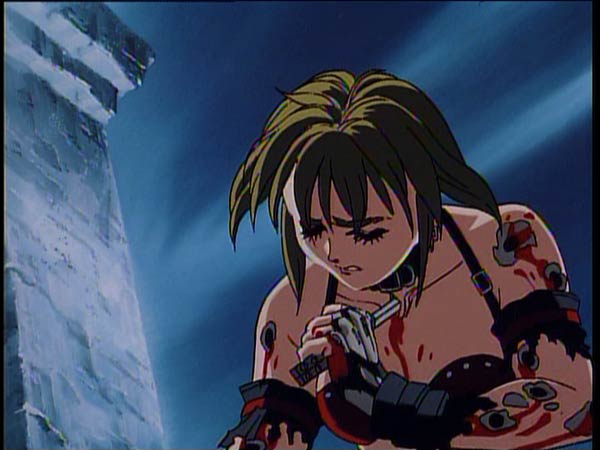
The Bottom Line: The visuals and sounds in Armitage III, while good, are somewhat dated and inconsistent. Some shots are absolutely superb, while others have a relatively plain background and almost 80s looking characters. Overall, there’s enough there to keep your interest, but its the story that delivers. Truly, I absolutely LOVE it!
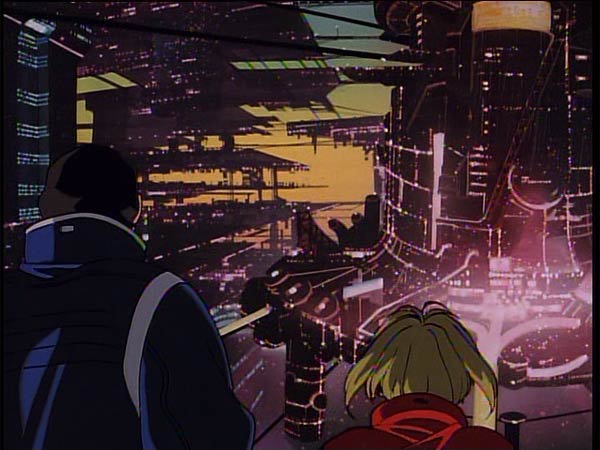
What is Armitage III Polymatrix? Polymatrix is a movie extracted from the 4 OAVs in Armitage III. While it is missing a few interesting scenes, its still watchable. It also has Kieffer Sutherland and Elizabeth Berkley as voice actors here, so if you can’t stand subtitles (You really fix this problem in the long run though), Polymatrix is a reasonable substitute. Some truly hate it primarily due to the English dubbing, the missing scenes and the changed ending. For me, I was OK with the dubbing, was generally OK with the scenes missing, but I liked the ending in the OAV (this movie) better.
~See movies similar to this one~
Year: 1998
Directed by: Ryutaro Nakamura
Written by: Chiaki Konaka
IMDB Reference
Degree of Cyberpunk Visuals: High
Correlation to Cyberpunk Themes: Very High
Key Cast Members:
Lain Iwakura: Kaori Shimizu

Overview: Serial Experiments Lain is a psychedelic, post-modern cyberpunk series that one wonders how the director ever managed to make. Lain centers on a very shy school girl who slowly begins to figure out that she is not what she seems to be. After getting a computer and connecting to the “wired,” something with is far more expansive than the internet, Lain begins to realize that she may not be human, and that truly, reality and the “self” is exists (or does not exist) on many different levels. As the story progresses, Lain “evolves” in terms of understanding what she is and her place in a very post-modern world. We also get many interesting side stories, including crime, teenage coming of age issues, and dastardly plots.

The pacing of Lain is just strange. Lain is NOT an action fest, nor is it by any means straight forward. Lain starts out rather slowly and gets weirder every episode. Truly, the story is told in a very “traditional” post-modern fashion in that we have fragmented vignettes structured in a seemingly random non-linear manner. Lain uses disconnected visuals to continually barrage the viewer with different textures, color schemes, and sounds. Yet over time, it becomes clear that the story is being spunk in seemingly a cyclical fashion, almost as if we are exploring a large Mandelbrot by starting at an outside spiral and slowly working our way around to the big picture. Each fragmented vignette gets added to until, at the end, we have a rather expansive tapestry to explore.
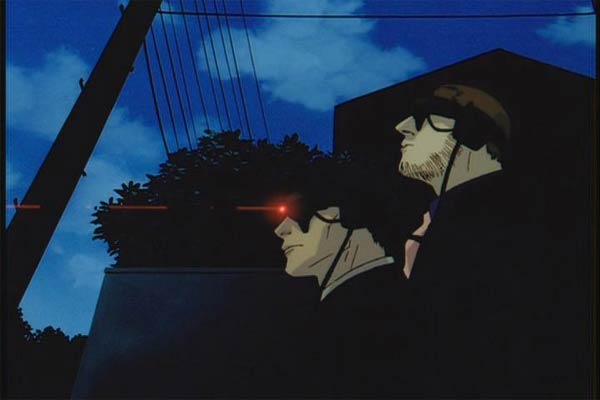
Many different and interesting philosophical ideas. But it is pure philosophical cyberpunk. Many key issues are discussed here, including:
- What constitutes “reality”?
- How real is time?
- What constitutes the “self” as a singular entity?
- What constitutes “God”?
- How are sentient programs different from humans?
- Is there such a thing as collective humanity?
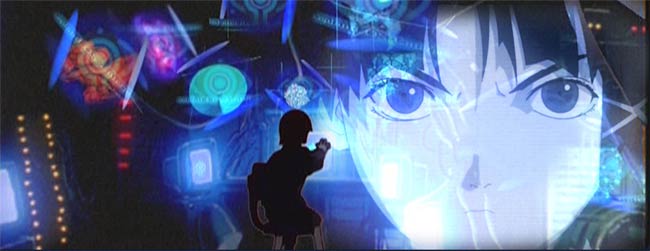
The visuals in Lain really aren’t there to “Wow” us as they are in some animes - instead they are often designed to provoke moods and thought patterns (BTW, there are so many screen caps available, that there was no need to take my own). Among the thought provoking visuals, we get:
- Psychedelic visions that explore multiple “selves” versus a singular “I”
- Juxtapositions of noise with false clarity
- Information Theory described visually
- An ever increasing feeling “disbelievability” each time the drab and normal school scene is shown.
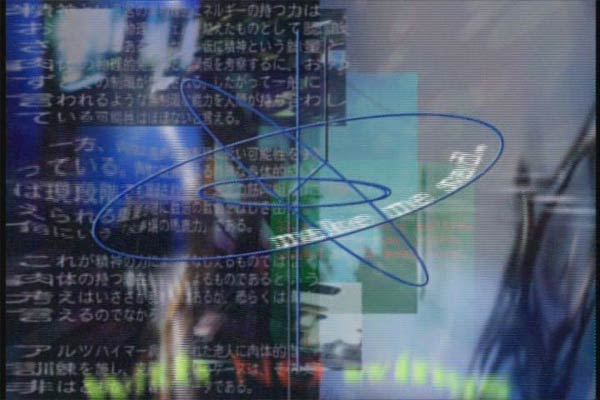
The Bottom Line: In the end, we are left with very open-ended thoughts. Serial Experiments Lain does not provide us with answers, instead, it opens us up to questions. And while I might argue that the post-modern pacing got too circular in places, and that I might argue the same tale could have been spun in half the time, the overall effect is rather extraordinary.
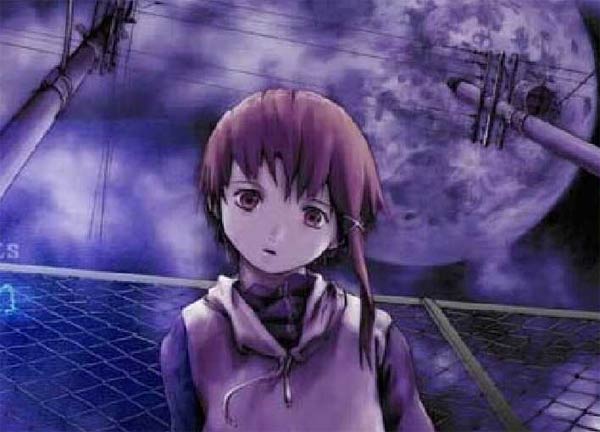
~See movies similar to this one~
Tags: cyberpunk movie review anime Serial Experiments Lain
|











































































